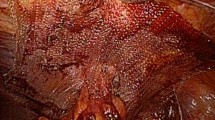Abstract
Background
Open surgery for parastomal hernia has been associated with high morbidity and recurrence rates exceeding 50%. Laparoscopic mesh repair is a promising alternative. Published series on laparoscopic mesh repair of parastomal hernia, however, are few with relative short follow-up.
Methods
Seventy-two consecutive patients with 48 paracolostomy and 24 paraileostomy hernias were studied prospectively. Using a two-layer mesh with polypropylene on the parietal side and nonadhesive PTFE toward the viscera, a slit with a central keyhole was cut in the mesh modified after Hofstetter. Covering the fascial defect, the slit was closed laterally. Of the 70 patients discharged alive, 66 were followed for 6 months to 11 years (median = 3 years). Four patients were lost for follow-up.
Results
Lysis of adhesions to the anterior abdominal wall, necessary in 68 patients (94%), was frequently a cumbersome and time-consuming task. In nine patients it was the apparent cause of inadvertent full-thickness enterotomy and seromuscular lesion in three and six patients, respectively. Three procedures (4%) were converted to open surgery. Postoperative complications were observed in 16 patients (22%), nine of whom required repeat surgery (13%). Two patients (3%) died. The median hospital stay was 3 days. Late mesh-related complications were observed in five patients (7%) after 5–34 months. Three patients developed abscess that required mesh removal in two patients, including one patient with a small bowel fistula. In two patients the mesh was removed because of small-bowel obstruction and stenosis of the colon at the level of the mesh, respectively. Parastomal hernia recurred in two patients 1 month and 52 months after surgery (recurrence rate = 3%, 95% confidence interval = 1–10).
Conclusions
Laparoscopic repair of parastomal hernia using bilayer mesh with a slit is associated with a risk of substantial postoperative morbidity, including late mesh-related complications, but a recurrence rate of less than 10%.

Similar content being viewed by others
References
Rubin MS, Schoetz DJ, Matthews JB (1994) Parastomal hernia—is stoma relocation superior to fascial repair? Arch Surg 129:413–419
Carne PWG, Robertson GM, Frizelle FA (2003) Parastomal hernia. Br J Surg 90:784–793
Rieger N, Moore J, Hewett P, Lee S, Stephens J (2004) Parastomal hernia repair. Colorectal Dis 6:203–205
Morris-Stiff G, Hughes LE (1998) The continuing challenge of parastomal hernia: failure of a novel polypropylene mesh repair. Ann R Coll Surg Engl 80:184–187
Porcheron J, Payan B, Balique JG (1998) Mesh repair of paracolostomy hernia by laparoscopy. Surg Endosc 12:1281
Bickel A, Shinkarevsky E, Eitan A (1999) Laparoscopic repair of paracolostomy hernia. Laparoendosc Adv Surg Tech A 9:353–355
Voitk A (2000) Simple technique for laparoscopic hernia repair. Dis Colon Rectum 43:1451–1453
Leblanc KA, Bellanger DE (2002) Laparoscopic repair of parastomy hernia: early results. J Am Coll Surg 194:232–239
Gould JC, Ellison EC (2003) Laparoscopic parastomal hernia repair. Surg Endosc Percutan Tech 13:51–54
Leblanc KA, Bellanger DE, Whitaker JM, Hausman MG (2005) Laparoscopic parastomal hernia repair. Hernia 9:140–144
Hansson BME, deHingh IH, Bleichrodt RP (2007) Laparoscopic parastomal hernia repair is feasible and safe: early results of a prospective clinical study including 55 consecutive patients. Surg Endosc 21:989–993
Berger D, Bientzle M (2007) Laparoscopic repair of parastomal hernias: a single surgeon’s experience in 66 patients. Dis Colon Rectum 50:1668–1673
Mancini GJ, McClusky DA, Khaitan L, Goldenberg EA, Heniford BT, Novitsky YW, Park AE, Kavic S, LeBlanc KA, Elieson MJ, Voeller GR, Ramshaw BJ (2007) Laparoscopic parastomal hernia repair using a non-slit mesh. Surg Endosc 21:1487–1491
Muysoms FE, Hauters PJ, Nieuwenhove YV, Huten N, Claeys DA (2008) Laparoscopic repair of parastomal hernias: a multi-centre retrospective review and shift in technique. Acta Chir Belg 108:400–404
Craft RO, Huguet KL, McLemore EC, Harold KL (2008) Laparoscopic parastomal hernia repair. Hernia 12:137–140
Hofstetter WL, Vukasin P, Ortega AE, Anthone G, Beart RW (1998) New technique for mesh repair of paracolostomy hernias. Dis Colon Rectum 41:1054–1055
Sugarbaker PH (1985) Peritoneal approach to prosthetic mesh repair of paracolostomy hernia. Ann Surg 201:344–346
Stelzner S, Hellmich G, Ludwig K (2004) Repair of paracolostomy hernia with a prosthetic mesh in the intraperitoneal onlay position. Dis Colon Rectum 185:91
Hansson BM, Bleichrodt RP, de Hingh IH (2009) Laparoscopic parastomal hernia repair using a keyhole technique results in a higher recurrence rate. Surg Endosc 23(7):1456–1459
Safadi B (2004) Laparoscopic repair of parastomal hernia: early results. Surg Endosc 18:676–680
Steele SR, Lee P, Martin MJ, Mullenix PS, Sullivan ES (2003) Is parastomal hernia repair with polypropylene mesh safe? Am J Surg 185:436–440
Inan I, Gervaz P, Hagen M, Morel P (2007) Laparoscopic repair of parastomal hernia using a porcine dermal collagen (Permacol) implant. Dis Colon Rectum 50:1465
Franklin ME, Trevino JM, Portillo G, Vela I, Glass JL, Gonzalez JJ (2008) The use of porcine small intestine submucosa as a prosthetic material for laparoscopic repair in infected and potentially contaminated fields: long-term follow-up. Surg Endosc 22:1941–1946
Disclosures
Drs. P. Wara and L. Maagaard Andersen have no conflicts of interest or financial ties to disclose.
Author information
Authors and Affiliations
Corresponding author
Rights and permissions
About this article
Cite this article
Wara, P., Andersen, L.M. Long-term follow-up of laparoscopic repair of parastomal hernia using a bilayer mesh with a slit. Surg Endosc 25, 526–530 (2011). https://doi.org/10.1007/s00464-010-1205-9
Received:
Accepted:
Published:
Issue Date:
DOI: https://doi.org/10.1007/s00464-010-1205-9



